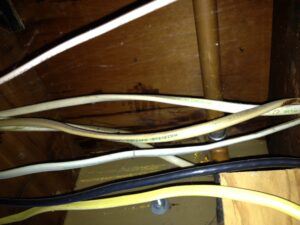Inspecting Branch Circuit Wiring Runs

Inspecting Branch Circuit Wiring Runs
Inspecting the electric service panel is something that home inspectors perform with great care and expertise. However branch circuit wiring is something that some inspectors do not pay as much attention to. Checking the receptacles with a meter or receptacle tester will give us an indication how the individual receptacle is wired. We also look at main service cables including clearances. But what about branch circuit wiring defects? I know that tracing all of the branch circuit wiring is impossible, but there are things we can inspect to ensure that our clients will not encounter a safety hazard. Wiring methods may also give us an indication of proper workmanship. For example, branch circuit wiring should be at least 6 feet away from attic access panels. Wiring protection is required for all cable running through joists, rafters, or studs less than 1 ¼ inch from any edge. When a home inspector is inspecting branch circuit wiring runs here are some of the conditions that should be noted:
- Non-Metallic or Armored Cable should not be used on the exterior
- All splices should be in a covered junction box that is accessible with an approved cover
- Damaged conductors or unsatisfactory repairs
- Conductors on A/C compressor / condenser units must be in flexible conduit
- Any cables less than 1 ¼” from the edge of wood members must be protected with a 1/16” metal strike plate
- NM cable should not be “pinched” by tight straps or staples
- One cable should pass through a single cable clamp connector or bushing unless the clamps are approved for more than one
- NM cable should be secured within 12” of metal boxes, 8” for plastic boxes and every 4 ½ feet throughout the run.
- All sheathing on NM wire should be intact where entering the junction box
- Unapproved exterior wiring
- There should be approximately ¼” of sheathing insulation inside the panel or junction box
- Conductors not entering panels or junction boxes with approved cable clamp bushings
- Non-Metallic or Armored Cable is buried outside or in conduit
- Metal electrical panels and junction boxes that are not grounded
- “Drop Cords” or extension cords used for permanent wiring
- NM conductors should be in conduit if penetrating concrete
A home inspector should always refer their client to a licensed electrician to make appropriate repairs. Electrical repairs should never be left to a homeowner.
Related Articles:
- The New Aluminum Wiring
- The Difference Between Electric Service Grounding
- Zinsco Electric Panels
- Reporting on 2 Slot Ungrounded receptacles
Want To Learn More? Click HERE to Search Our Full Database Of Home Inspector Newsletters.



